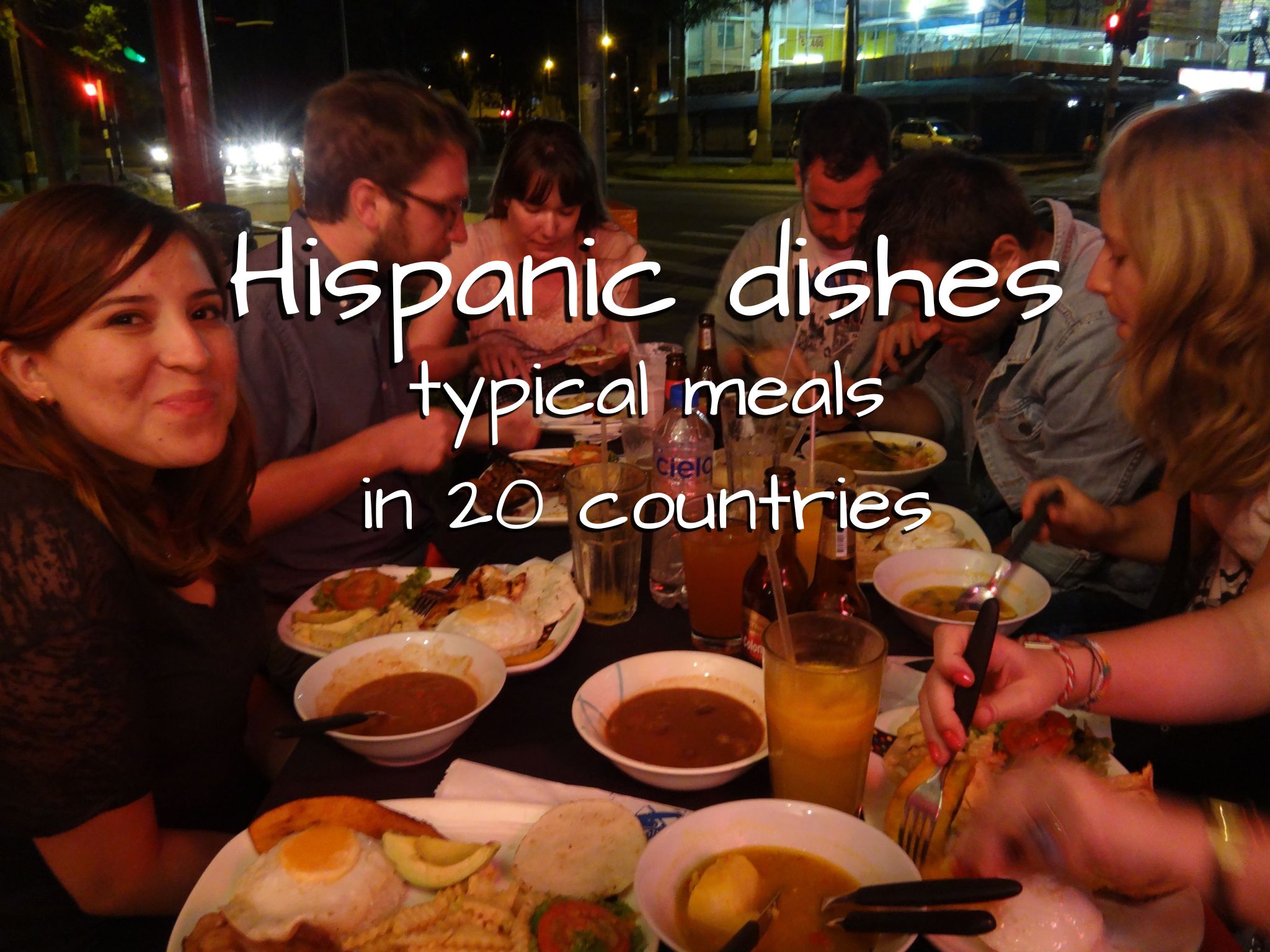Hispanic Food: A mouthwatering tour of the 20 best Hispanic dishes from each country

Get our free email course, Shortcut to Conversational.
Have conversations faster, understand people when they speak fast, and other tested tips to learn faster.
More infoHispanic cuisine is a treasure trove of flavors, traditions, and history, reflecting the diverse cultures and landscapes of the Spanish-speaking world.
In this article, we invite you on a gastronomic adventure as we explore the iconic national dishes of 20 Hispanic countries. These culinary delights are more than just meals: they are gateways to understanding the deep-rooted heritage and essence of each nation!
Whether you’re a language enthusiast, a curious traveler, or an adventurous foodie, this guide will provide a curated selection of must-try Hispanic dishes to enhance your journey through the Spanish-speaking world.
Spain – Paella
Originating in the Spanish coastal city of Valencia, paella is a culinary masterpiece celebrated for its saffron-infused yellow hue and a rich medley of flavors. This quintessential Spanish dish features a bed of perfectly cooked rice generously adorned with succulent seafood like shrimp, mussels, and calamari, alongside tender chicken, savory chorizo, and fresh vegetables. The combination of aromatic spices, such as saffron, paprika, and rosemary, creates a symphony of tastes that dance on the palate. Paella not only nourishes the body, but also represents the vibrant spirit and communal nature of Spanish gatherings.
Mexico – Pozole
In Mexico, pozole holds a special place in the hearts of its people and is often served during festivities and gatherings. This hearty and comforting soup showcases tender hominy kernels immersed in a robust broth, made from simmering pork or chicken with a blend of fragrant herbs and spices. The garnishes are what make pozole truly delightful: fresh lime, shredded cabbage, diced radishes, chopped onions, and fragrant oregano add layers of flavors and textures to this beloved Latin food.
Argentina – Asado
Asado is more than just a meal; it is a cherished cultural tradition in Argentina. This revered national dish involves grilling various cuts of beef, sausages, and offal over open flames, imparting a distinct smoky flavor to the meat. Patience is key, as the meats are slow-cooked to perfection, resulting in tender, juicy delights that tickle the senses. Asado stands as a magnificent representation of Argentinean culinary expertise, while its appreciation and admiration span the rich tapestry of Latin food culture.
Peru – Ceviche
Hailed as Peru’s national dish, ceviche is a vibrant and refreshing culinary marvel. The heart of this dish lies in its fresh raw fish or seafood, which is marinated in tangy citrus juices, often using lime or bitter oranges. The acidity “cooks” the seafood, creating a delightful texture. To enhance the taste, ceviche is seasoned with a mix of aromatic herbs, chili peppers, and red onions. Served with sweet potato and crunchy corn kernels, ceviche embodies the coastal influence of Peru’s culinary heritage and celebrates the country’s bountiful marine resources.
Colombia – Bandeja Paisa
Bandeja paisa, seen in our cover photo here at a local restaurant in BaseLang’s hometown of Medellín, is a generous and indulgent platter that showcases the diverse flavors of Colombia. This savory feast boasts an assortment of delights, including grilled steak, chicharron, chorizo sausage, white rice, red beans, fried egg, ripe plantains, and avocado slices.
Check out our post on bacon in Spanish to learn more about chicharrones and other variations of bacon eaten in Hispanic countries.
Chile – Pastel de Choclo
Pastel de choclo is a delicious Latin food that offers a delectable blend of savory and sweet flavors. This beloved Hispanic dish features a corn pie filled with a delightful mixture of seasoned ground beef, tender chicken, olives, raisins, and hard-boiled eggs. The corn topping, made from fresh ground corn kernels and basil, adds a hint of natural sweetness to the savory filling. Pastel de Choclo exemplifies the creative fusion of indigenous and Spanish influences that characterize Chilean cuisine.
Venezuela – Pabellón Criollo
Pabellón criollo is a culinary masterpiece that encapsulates the essence of Venezuela’s gastronomic heritage. This hearty plate consists of shredded beef, black beans seasoned with spices, white rice, and ripe plantains. The ingredients are carefully prepared and seasoned to perfection, allowing the flavors to harmonize into a truly satisfying and comforting meal.
Cuba – Ropa Vieja
Ropa vieja, meaning “old clothes” in Spanish, is a cherished Cuban dish renowned for its tender shredded beef cooked in a fragrant tomato-based sauce, studded with bell peppers and onions. The name originates from the dish’s resemblance to tattered garments, but its taste is anything but ragged. The slow-cooked beef absorbs the flavors of the sauce, creating a melt-in-your-mouth experience that delights the senses. Ropa vieja reflects the resilience and resourcefulness of Cuban culture, transforming simple ingredients into a culinary masterpiece.
Dominican Republic – La Bandera
La bandera, meaning “the flag” in Spanish, is a classic Dominican meal comprised of white rice, red beans, and stewed meat, often accompanied by fried green plantains. La bandera is a staple in many Dominican restaurants and households, making it easily accessible to those who want to explore Dominican cuisine. Trying this dish can be an excellent introduction to the country’s culinary delights.
Ecuador – Encebollado
Encebollado holds a special place in Ecuadorian cuisine, particularly along the coastal regions. This hearty fish soup features flaked tuna marinated in a zesty mixture of lime juice, tomatoes, and onions. The broth, often made from fish stock, is seasoned with cumin, achiote, and cilantro, infusing the dish with a burst of flavors. Depending on the region, it can be served with ripe plantains or popcorn on the side.
Guatemala – Pepián
Pepián is a flavorsome meat stew, boasting a base of toasted seeds, vegetables, and chili peppers, representing Guatemala’s pre-Hispanic culinary heritage. This flavorful dish used to be served in Mayan religious ceremonies, and now it’s typically served during family gatherings, religious festivals, or weddings.
Honduras – Carneada
Carneada, also known as plato típico, meaning “typical dish,” is a festive culinary tradition in Honduras. A proper carneada is almost an event on its own, as it involves a communal pig roast to celebrate special occasions such as birthdays, anniversaries, and holidays. The pig is marinated and cooked slowly over open flames, resulting in tender and flavorful meat.
Nicaragua – Gallo Pinto
Gallo pinto is a delicious combination of rice and beans, often served with eggs, cheese, and plantains, making it a quintessential Nicaraguan breakfast. Families start their day with gallo pinto, appreciating its simplicity and the way it unites Nicaraguans through shared tastes and traditions.
Costa Rica – Casado
Casado translates to “married man” in Spanish, symbolizing a marriage of flavors on a single plate: rice, black beans, plantains, salad, and a choice of meat. This wholesome and balanced meal is widely consumed throughout the country, and is one of those Latin foods that you can’t miss if you are an enthusiast of food and culture mixed together.
El Salvador – Pupusa
Pupusas are thick corn tortillas filled with cheese, beans, or meat, typically accompanied by a spicy cabbage slaw known as curtido. Families often bond over the process of making this Hispanic dish, turning it into a social event filled with laughter, stories, and a sense of cultural heritage.
Uruguay – Chivito
Chivito is a scrumptious steak sandwich, typically including tender beef, cheese, bacon, lettuce, tomato, and mayonnaise, served with fries. Chivitos are often enjoyed as a satisfying meal during family outings, picnics, or celebrations.
Paraguay – Sopa Paraguaya
Despite its name, sopa paraguaya is not a soup but a dense cornbread, incorporating cheese and onions. This delicious Latin food can be served hot or cold, as a main or a side dish. What is certain is that no matter how you eat it, it will always be delicious.
Puerto Rico – Mofongo
Mofongo is a dish made from mashed green plantains mixed with garlic, salt, and chicharrón, forming a flavorful side dish. Families enjoy mofongo during celebratory meals, holidays, and special occasions, savoring its unique blend of Puerto Rican flavors.
Bolivia – Salteñas
Salteñas are baked pastries filled with a savory mixture of meat, vegetables, and a slightly sweet, spicy sauce, popular throughout Bolivia. This dish is very affordable and can be found practically everywhere in Bolivia, so you won’t have to struggle to find it. It is mostly eaten as a breakfast or as a midday snack.
Panama – Sancocho de Gallina
Panama’s version of sancocho is a chicken soup featuring corn, yams, plantains, and achiote, making it a cherished comfort food. Families often gather for sancocho during cold or rainy days, weekends, or social events, enjoying its nourishing qualities and the sense of unity it brings to the table.
Conclusion
In this mouthwatering journey, we’ve explored 20 of the best Hispanic dishes. We introduced a delicious typical dish from each Spanish-speaking country, showcasing the diverse flavors, traditions, and cultural significance of each culinary masterpiece.
From Spain’s iconic paella to Puerto Rico’s unique mofongo, each dish represents more than just food: it embodies the heritage, values, and shared experiences of its people. So, whether you’re a language enthusiast, a curious traveler, or an adventurous foodie, share this post with your fellow Spanish enthusiasts for a delicious taste of Latin food and Hispanic dishes.
¡Buen provecho! – Bon appétit!



